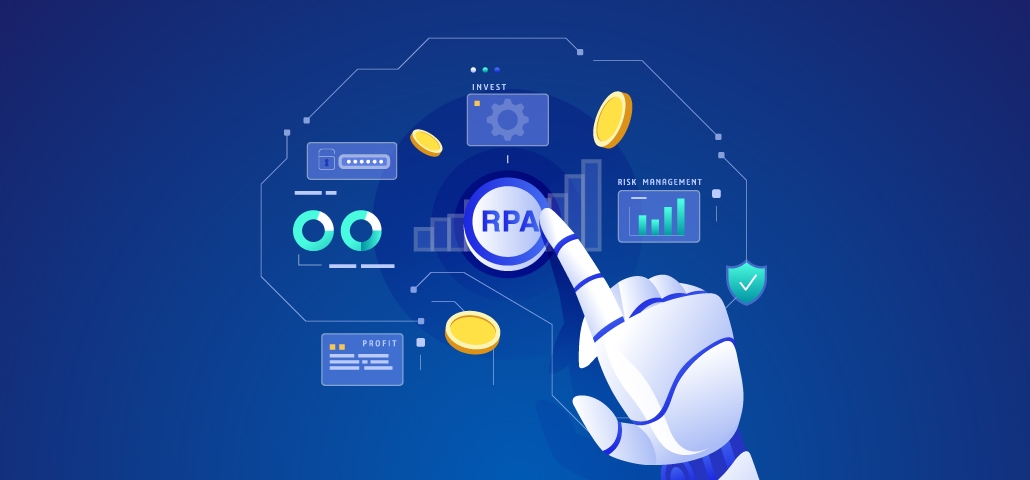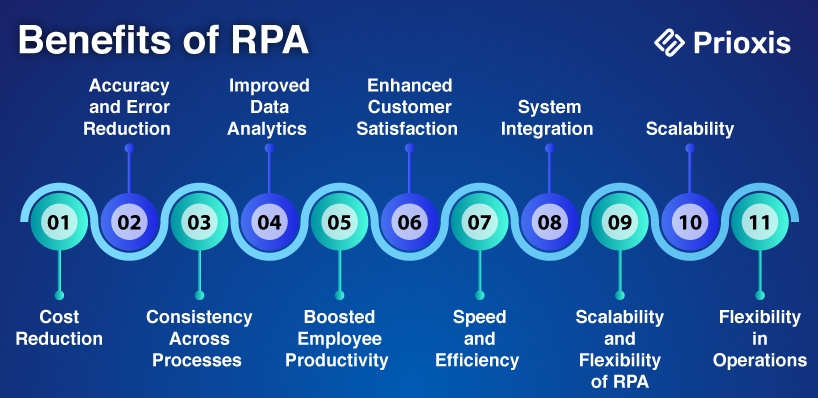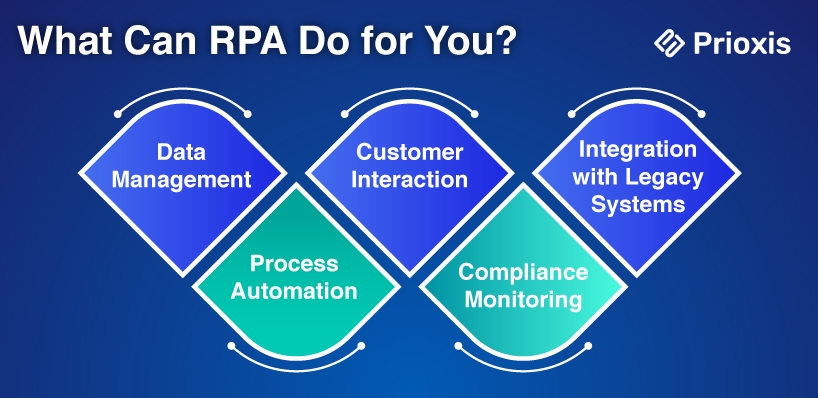Top Benefits of Robotic Process Automation in 2025
 Admin
Admin Digital Transformation
Digital Transformation Aug 28, 2024
Aug 28, 2024

Table of Content
RPA, as the name itself suggests, is a technology that uses automated robots to perform repetitive, rule-based tasks continuously and efficiently.
These RPA bots mimic human-like behavior and perform tasks just like a human worker, such as navigating systems, entering data, processing digital transactions, and providing customer support. RPA bots not only save valuable labor hours, but also reduce human error, improve efficiency, and conserve financial resources. Let’s discuss these robotic process automation(RPA) benefits in great detail.
What is Robotic Process Automation?
RPA is a business process automation technology that uses digital robots, or bots, to perform time-consuming and manual tasks.
One common example of RPA in action is when you visit a website and encounter a chat box that opens with an automated message—this is an application of RPA. Other examples include filling fields in forms and the automated processing of transactions in digital systems. Key RPA benefits include error-free processes, allowing your human workforce to be invested in other core and important business processes.
What Can RPA Do for You?
The most essential question is: What can RPA do for my business? Here are a few functions that RPA bots can perform better than humans.
1. Data Management
RPA bots can manage vast amounts of data across different systems, ensuring that information is consistent, accurate, and up to date. They can extract data from one system, process it, and input it into another system, reducing the need for manual data entry and minimizing errors.
2. Process Automation
RPA excels at automating repetitive, rules-based tasks. For instance, RPA bots can automate invoice processing, order management, and payroll administration. This not only speeds up these processes but also reduces the likelihood of human error.
3. Customer Interaction
Robotic Process Automation can enhance customer interactions by providing faster and more accurate responses. Bots can handle routine inquiries, process service requests, and even guide customers through troubleshooting steps, freeing up human to handle more complex issues.
4. Compliance Monitoring
In industries with stringent regulatory requirements, RPA can ensure that processes are consistently followed according to the rules & regulations. Bots can track compliance, generate reports, and alert management to any deviations from standard and pre-defined procedures.
5. Integration with Legacy Systems
One of the significant Robotic Process Automation Benefits is its ability to work with existing systems, including older, legacy systems. RPA bots interact with these systems at the user interface level, making it possible to automate processes without the need for costly and time-consuming system upgrades.
Explore Further: RPA Use Cases
RPA Benefits Across Your Business
RPA's ability to automate and streamline processes can benefit nearly every department within an organization. Here are some examples:
1. Procurement
In procurement, RPA can automate the inventory reconciliation process. This automation can lead to a 70% reduction in the time it takes to reconcile inventory, as noted by Supply Chain Brain.
By speeding up this process, businesses can better manage their inventory levels, reduce costs, and improve their supply chain efficiency.
2. Accounting
In the accounting department, RPA can significantly reduce the time spent on repetitive tasks such as data entry, invoice processing, and reconciliations. According to Gartner, up to 30% of an accountant's time can be spent on avoidable rework, which RPA can help eliminate. This allows accountants to focus on more strategic activities, such as financial analysis and planning.
3. IT Services
RPA can also optimize IT services. Gartner's 2020 report on IT cost optimization found that automation can help organizations achieve 10-15% savings in ongoing IT service project costs. RPA bots can handle routine managed IT tasks, such as software updates, system monitoring, and user support, freeing up IT staff to focus on more complex issues.
4. Sales
In sales, RPA can automate up to 80% of the purchase order process. This not only speeds up order processing but also reduces the chances of errors, ensuring that customers receive their orders promptly and accurately. As a result, sales teams can focus on building relationships with customers and closing deals.

5. Cost Saving
Implementing RPA can lead to significant cost savings. By automating routine tasks, businesses can reduce their reliance on human labor for these activities. It is estimated that RPA can cut operational costs by 25-50%, with robots working 24/7 without the need for breaks, vacations, or overtime pay. These savings can be reinvested into more strategic initiatives, further driving business growth.
6. Improved Accuracy and Consistency
RPA reduces the likelihood of errors in business processes. Bots follow predefined rules with precision, ensuring that tasks are completed accurately every time. This improvement in accuracy reduces the need for rework and enhances the overall quality of business operations.
RPA delivers consistent results across all processes. Unlike human workers, who may vary in performance, RPA bots perform tasks the same way every time, ensuring uniformity in outputs and reducing variability in process outcomes.
7. Improved Productivity & Customer Satisfaction
RPA allows employees to focus on higher-value activities that require human judgment and creativity by automating repetitive tasks. This leads to increased employee satisfaction and productivity.
Additionally, RPA enhances customer service by accelerating processes and minimizing errors. It enables faster response times and accurate service delivery, which contribute to higher customer satisfaction. With routine tasks automated, customer service representatives can concentrate on providing personalized support, further enriching the customer experience.
8. Faster Process & System Integration
RPA can complete tasks much faster than human workers. For example, a task that might take a human employee several hours to complete can be done by an RPA bot in a matter of minutes. This speed is crucial in industries where time-sensitive processes are critical to success. RPA bots can be integrated with multiple digital systems across various industries, significantly accelerating business processes and ultimately leading to increased revenue.
9. Improve Data Analytics
RPA can gather and process data from multiple sources, providing businesses with accurate and timely insights. This data can be used to improve decision-making, optimize processes, and identify areas for improvement. With better analytics, businesses can stay ahead of the competition and make informed strategic decisions.
10. Scalability and Flexibility
RPA systems are inherently scalable, allowing businesses to adjust the number of bots based on demand. This flexibility makes it easy to scale operations up or down as needed, ensuring that resources are used efficiently and effectively.
RPA vs. BPA: Key Differences
While RPA and Business Process Automation (BPA) are often mentioned together, they are not the same. Understanding the difference between the two is crucial for businesses looking to implement automation solutions.
| RPA | BPA |
|---|---|
| RPA focuses on automating specific, rule-based tasks within a business process. RPA is ideal for automating repetitive tasks that do not require complex decision-making or deep integration with other systems. | BPA is a broader approach that encompasses the entire automation strategy within an organization. BPA aims to streamline operations across multiple functions and systems, often requiring more complex integration and workflow management. |
| RPA can be seen as a subset of BPA. RPA is a specific tool that can be used within BPA to handle repetitive tasks. | BPA covers the entire spectrum of process automation. RPA and BPA can create a comprehensive automation strategy that optimizes both individual tasks and entire processes. |
| RPA is rigid in its application, as it focuses on predefined tasks with clear rules. | BPA is more flexible and adaptable than RPA because it involves customizing automation solutions to fit the specific needs of an organization. |
| RPA is best suited for tasks like data entry, transaction processing, and simple customer service interactions. | BPA is used for more complex workflows that require coordination across multiple departments and systems, such as end-to-end supply chain management or enterprise resource planning. |
Explore Further: RPA Best Practices
Final Thoughts: How RPA Can Make a Difference in Your Business
As technology continues to evolve, the potential for RPA will only grow, making it an essential component of any modern business strategy. At Prioxis, we don't just implement RPA—we craft tailor-made automation strategies that align with your business vision. We are integrating several other technologies with RPA, such as cloud computing, machine learning, and computer vision.
Our team of RPA experts dives deep into your business operations, identifying the most impactful areas for automation, and delivering solutions that drive real results.
Get in touch

